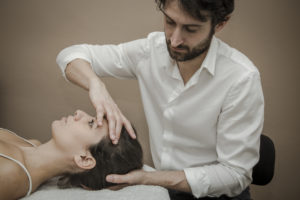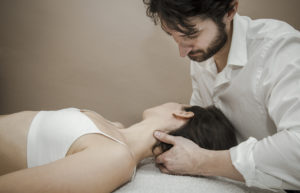
Osteopathy is a form of drug-free non-invasive manual medicine that focuses on total body health by treating and strengthening the musculoskeletal framework, which includes the joints, muscles, and bones. In some cases the site of your pain is not necessarily the cause, and a careful examination will reveal imbalances within the body.
The philosophy of Osteopathy is what sets it apart from other medical disciplines. The key principles are based on all parts of the body functioning together in an integrated manner. If one part of the body is restricted, then the rest of the body must adapt and compensate for this, eventually leading to inflammation, pain, stiffness and other health conditions. When the body is free of restrictions in movement, Osteopathic treatment assists the body with pain minimisation, reduced stress and greater mobility providing the body with the opportunity to heal itself.
Osteopaths use a broad range of gentle hands-on techniques including soft tissue stretching, deep tactile pressure, and mobilisation or manipulation of joints. Osteopaths believe in working as part of a health system of health providers and often refer to the G.P. or another allied health professional where appropriate.
What Osteopaths treat
Osteopathy is manual therapy that can diagnose the cause and provide treatment for a wide range of issues.
- Sports Injuries
- Back Pain and sciatica
- Neck and Shoulder Pain
- Headaches & Migraines
- Pre and Post-natal pain
- Knee, foot, and ankle injuries
- Repetitive strain injuries
- TMJ (jaw) problems
- Digestive problems
- General aches and pains
This list is not exhaustive so if you are not sure if we can help you, please don’t hesitate to get in touch.
The Initial Consultation
During the initial consultation, the osteopath will take a medical history and conduct a physical examination. They will also ask about your symptoms, lifestyle, and any previous treatments you have received for your condition. Based on this information, the osteopath will develop a treatment plan. The patient may be asked to perform some simple movements. This is so the osteopath can observe how the patient is using their body, identify any obvious mobility impairment if there are. Neurological and orthopaedic tests help the osteopath to eliminate possible underlying pathologies and differentiate the basis of the patient’s complaint. The initial consultation will take around 60 minutes to complete, after which the osteopath will be able to offer a diagnosis and discuss a treatment program. Treatment could include such techniques as soft tissue stretching, to increase blood flow and improve flexibility of joints and muscles; articulation to mobilise joints by being passively taken through their range of motion; and muscle energy, to release tightness on the muscles by alternatively being stretched and made to work against resistance. Please note you may be asked to undress during the session but we provide towels and covers so you feel more comfortable and if you prefer you can bring shorts or other loose clothing, just let the osteopath know what suits you. If you are unsure whether we can help you please don’t hesitate to contact us either by email or phone and we will get back to you very quickly.
The Follow-up appointment
During osteopathy follow up, the practitioner will assess the patient’s progress since the last treatment. They will ask about any changes in symptoms, as well as how the patient has been responding to the treatments. The practitioner will then perform a physical examination, which may include palpation, range of motion testing, and muscle strength testing. Based on their findings, the practitioner will develop a plan for further treatment. The goal of osteopathy is to help the patient achieve long-term relief from pain and improve their overall quality of life.






